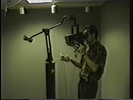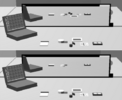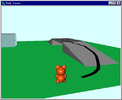





We introduce TwinSpace, a flexible software infrastructure for combining interactive workspaces and collaborative virtual worlds. Its design is grounded in the need to support deep connectivity and flexible mappings between virtual and real spaces to effectively support collaboration. This is achieved through a robust connectivity layer linking heterogeneous collections of physical and virtual devices and services, and a centralized service to manage and control mappings between physical and virtual. In this paper we motivate and present the architecture of TwinSpace, discuss our experiences and lessons learned in building a generic framework for collaborative cross-reality, and illustrate the architecture using two implemented examples that highlight its flexibility and range, and its support for rapid prototyping.















Efficiently entering text on interactive surfaces, such as touch-based tabletops, is an important concern. One novel solution is shape writing - the user strokes through all the letters in the word on a virtual keyboard without lifting his or her finger. While this technique can be used with any keyboard layout, the layout does impact the expected performance. In this paper, I investigate the influence of keyboard layout on expert text-entry performance for stroke-based text entry. Based on empirical data, I create a model of stroking through a series of points based on Fitts's law. I then use that model to evaluate various keyboard layouts for both tapping and stroking input. While the stroke-based technique seems promising by itself (i.e., there is a predicted gain of 17.3% for a Qwerty layout), significant additional gains can be made by using a more-suitable keyboard layout (e.g., the OPTI II layout is predicted to be 29.5% faster than Qwerty).



























We introduce TwinSpace, a flexible software infrastructure for combining interactive workspaces and collaborative virtual worlds. Its design is grounded in the need to support deep connectivity and flexible mappings between virtual and real spaces to effectively support collaboration. This is achieved through a robust connectivity layer linking heterogeneous collections of physical and virtual devices and services, and a centralized service to manage and control mappings between physical and virtual. In this paper we motivate and present the architecture of TwinSpace, discuss our experiences and lessons learned in building a generic framework for collaborative cross-reality, and illustrate the architecture using two implemented examples that highlight its flexibility and range, and its support for rapid prototyping.